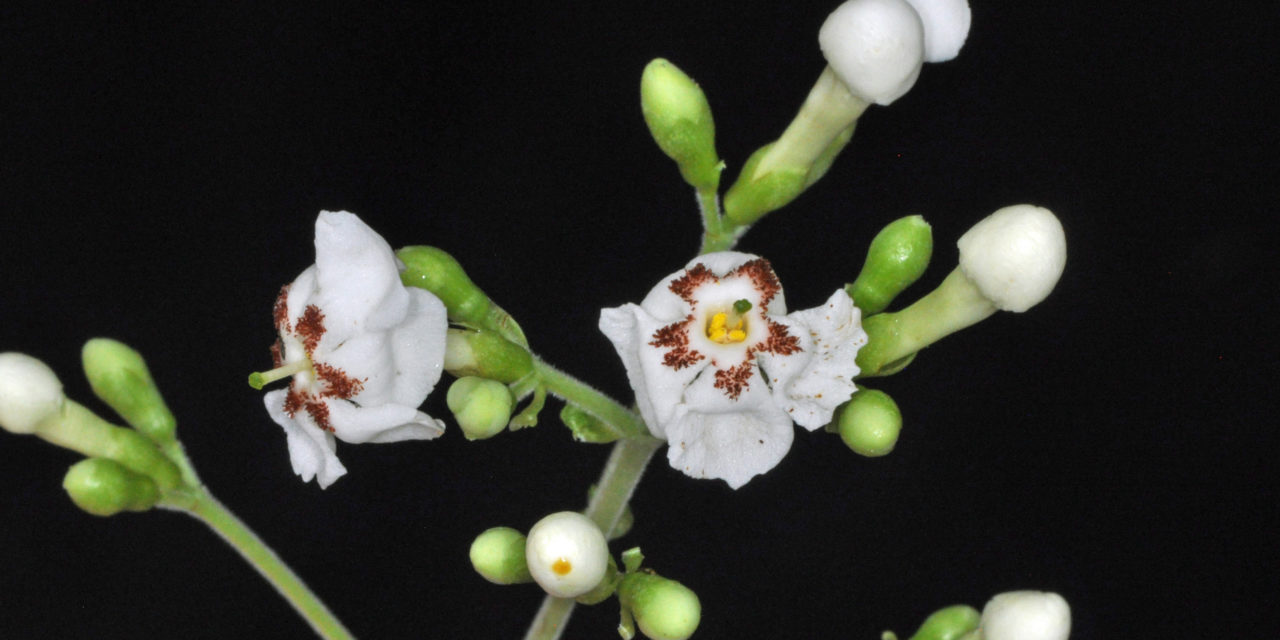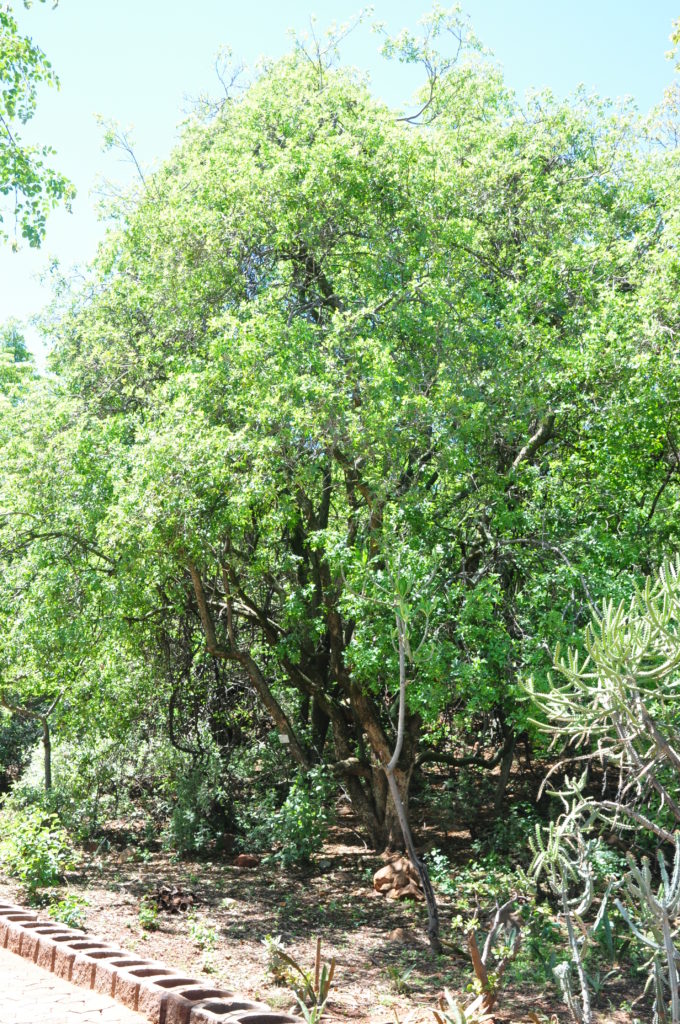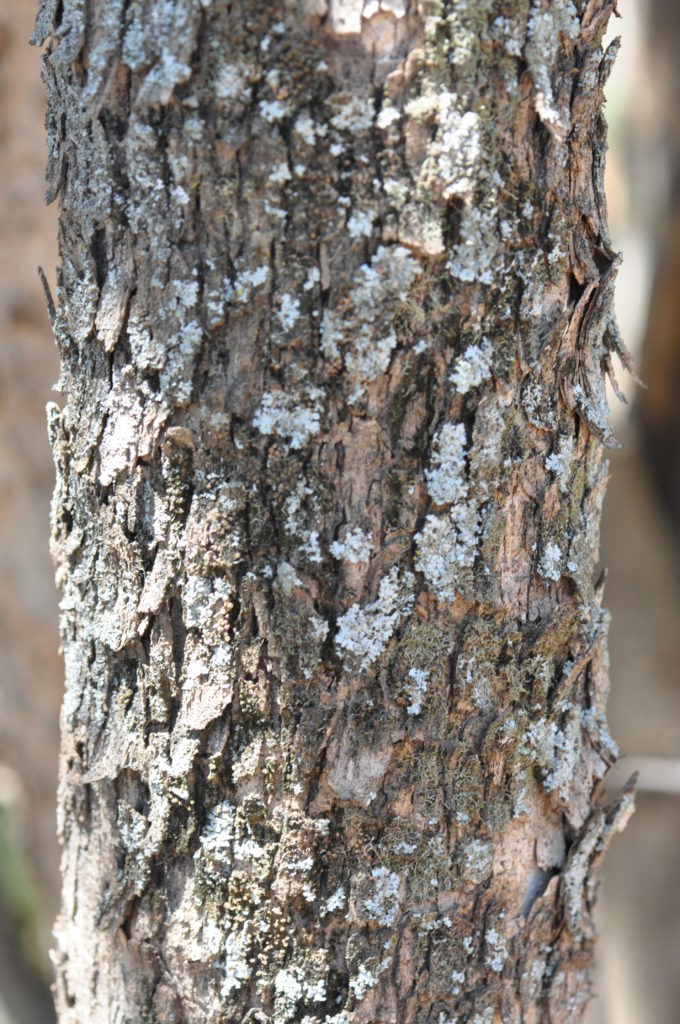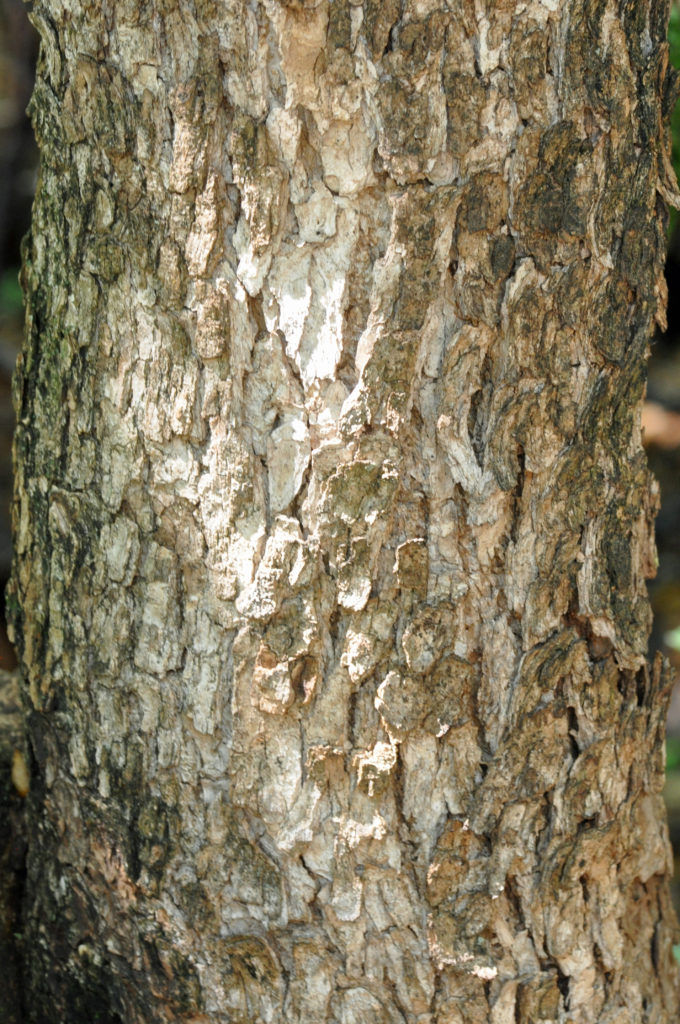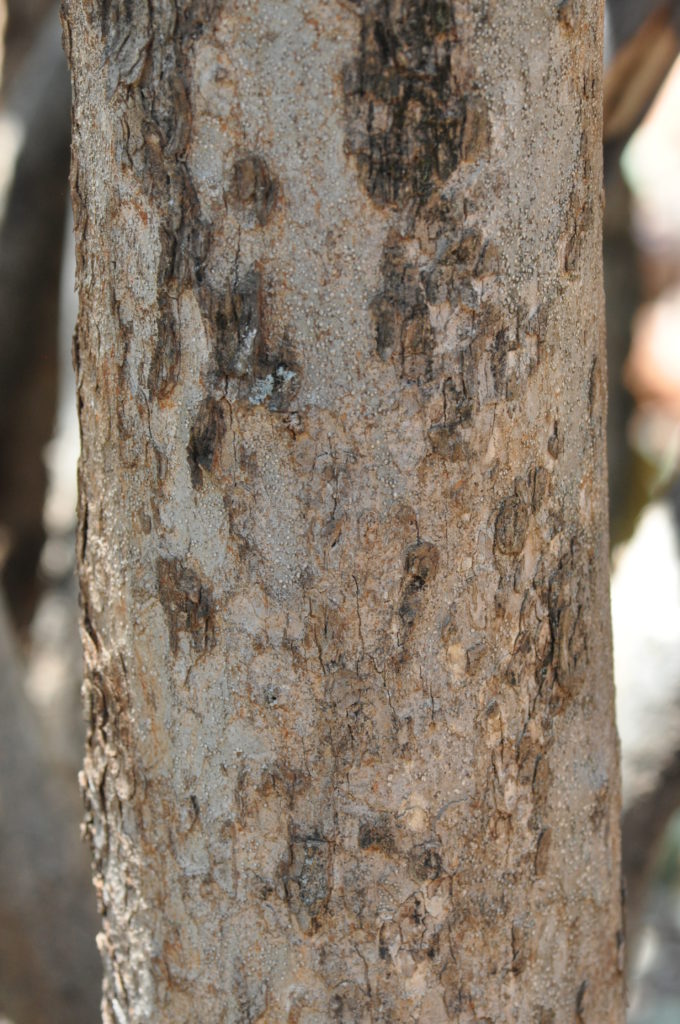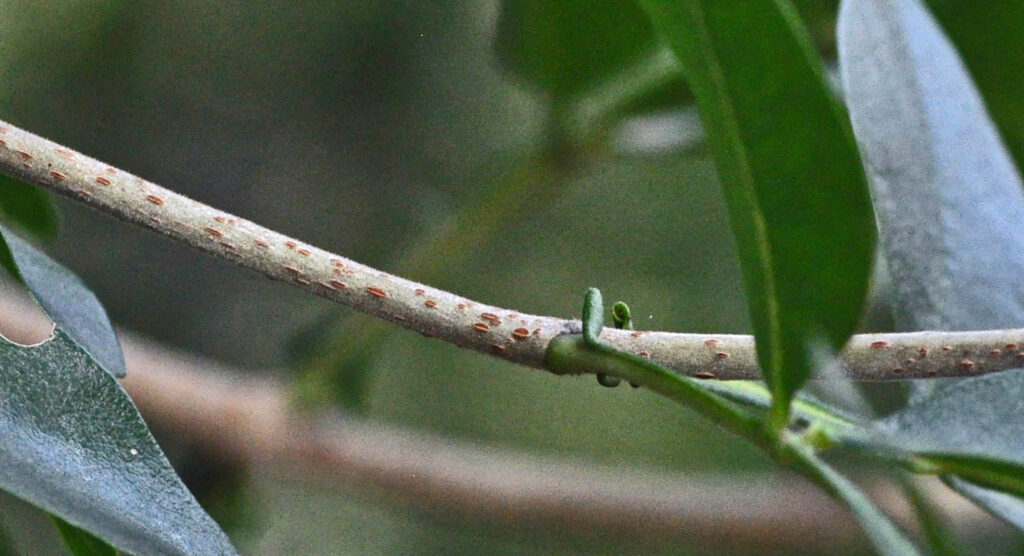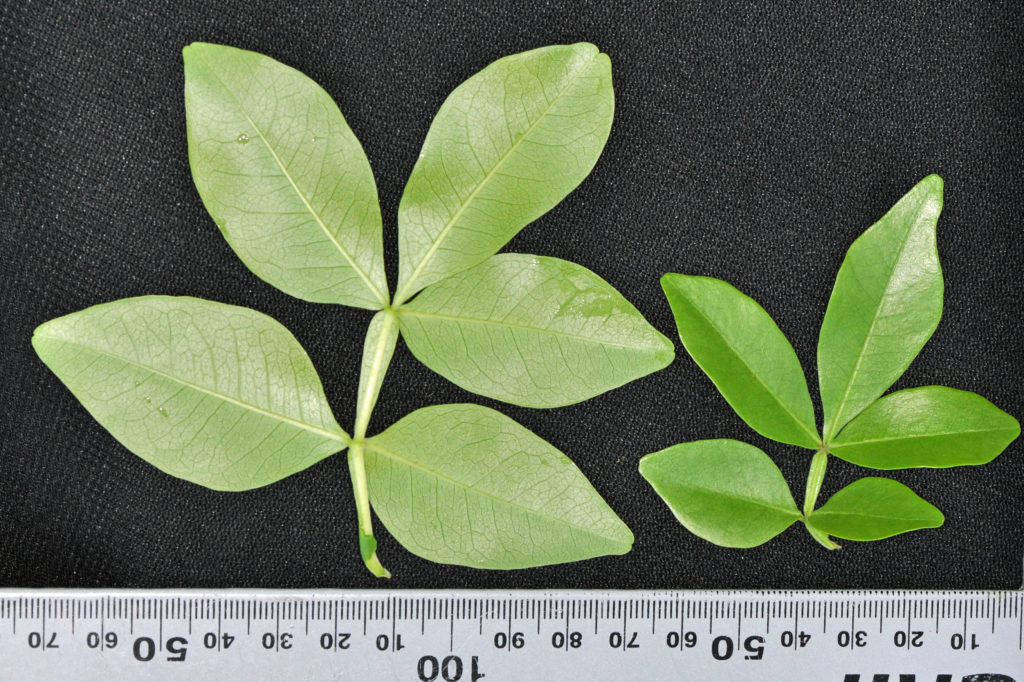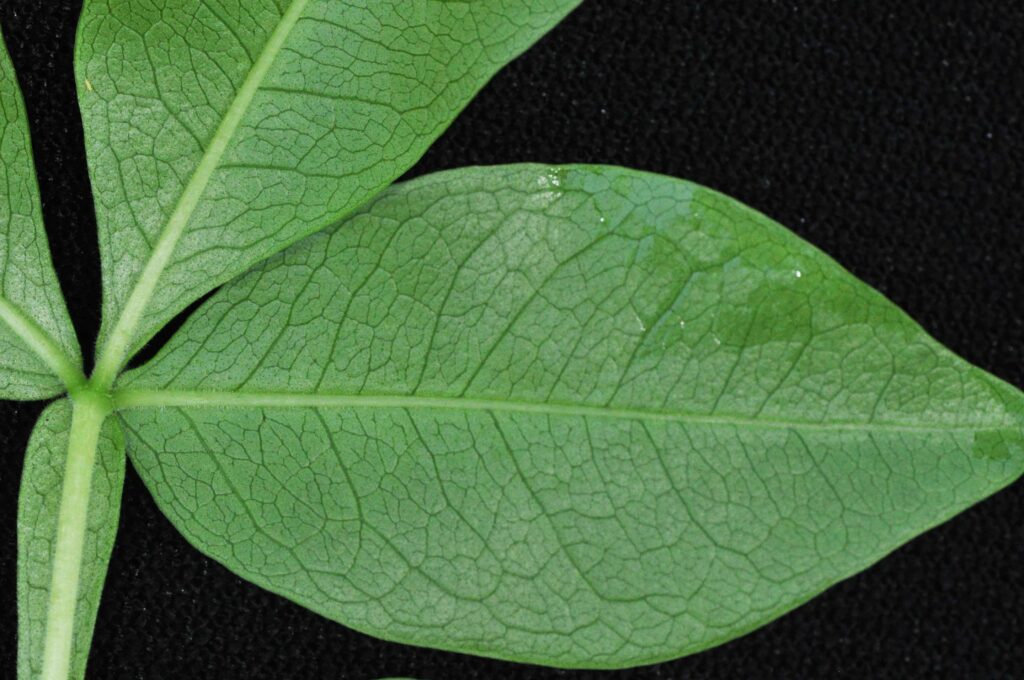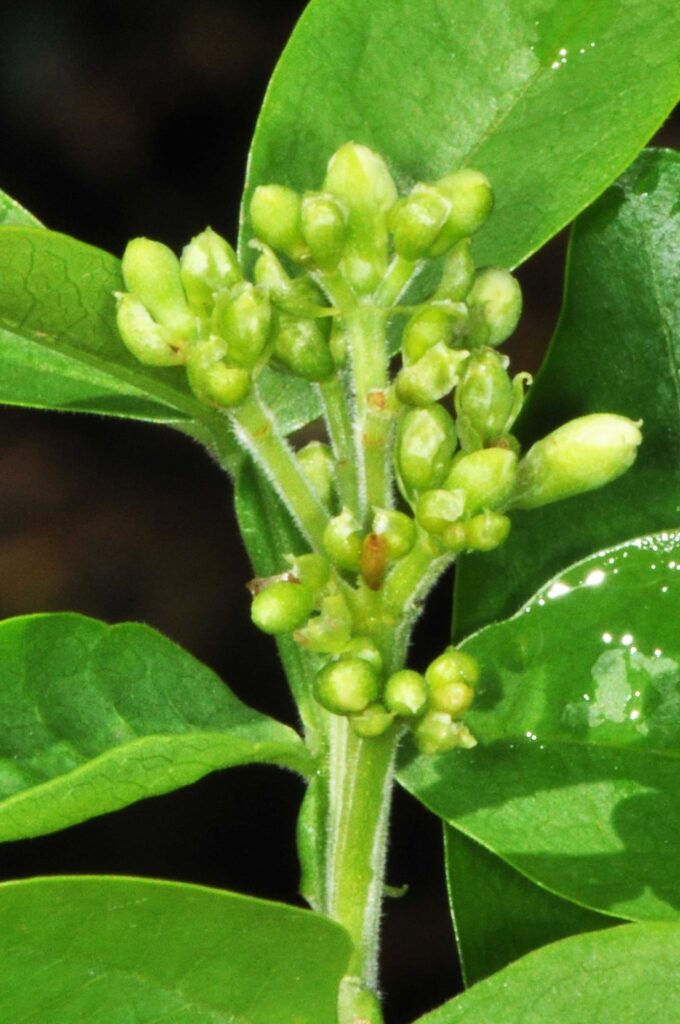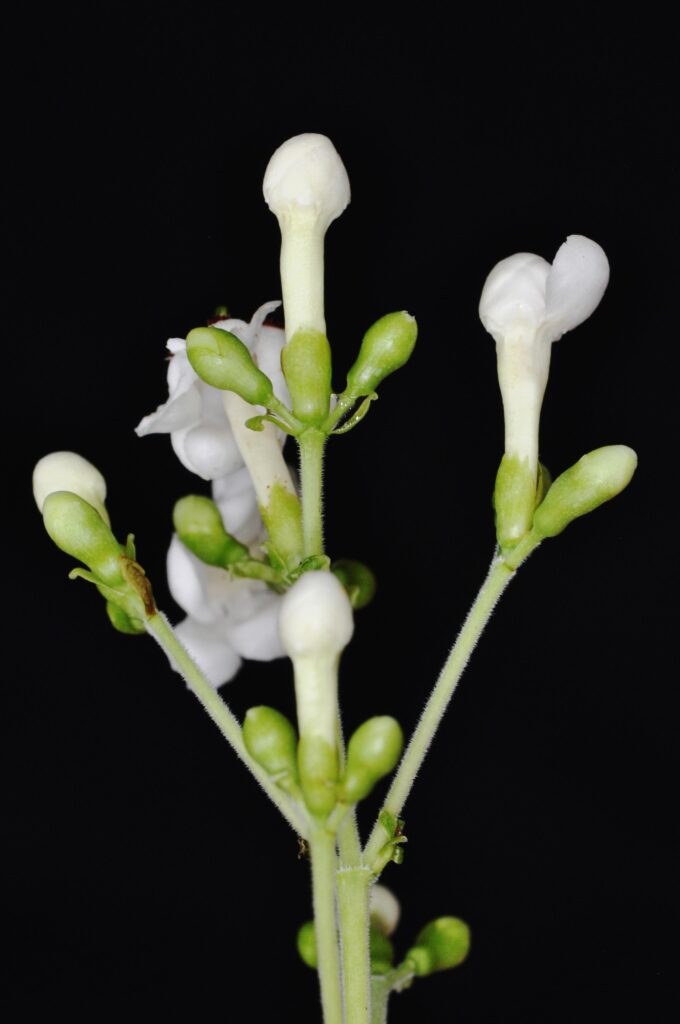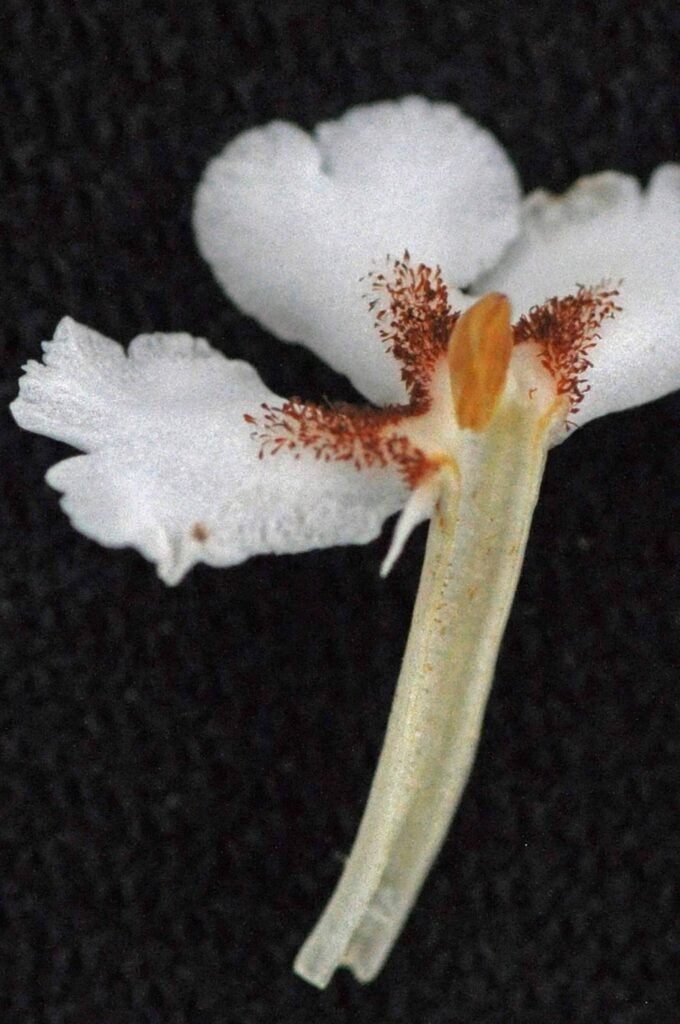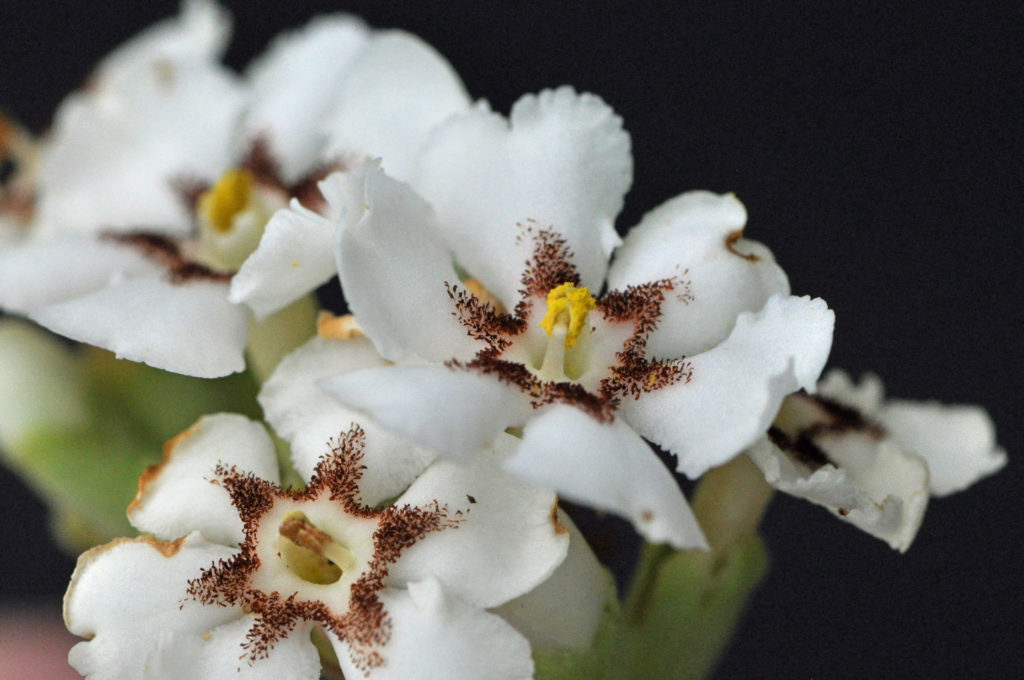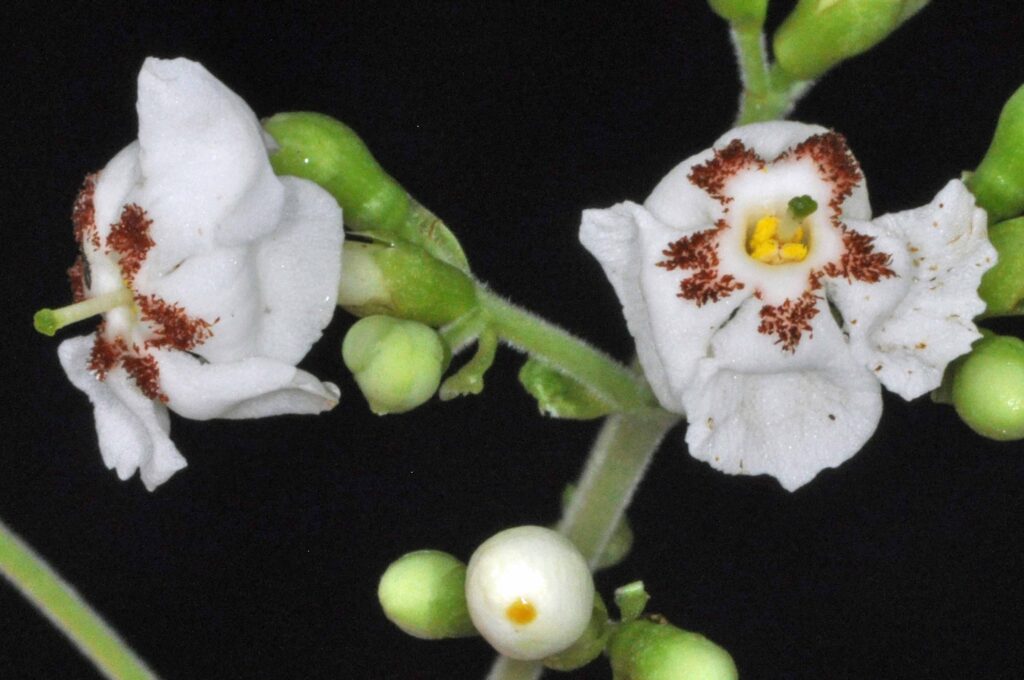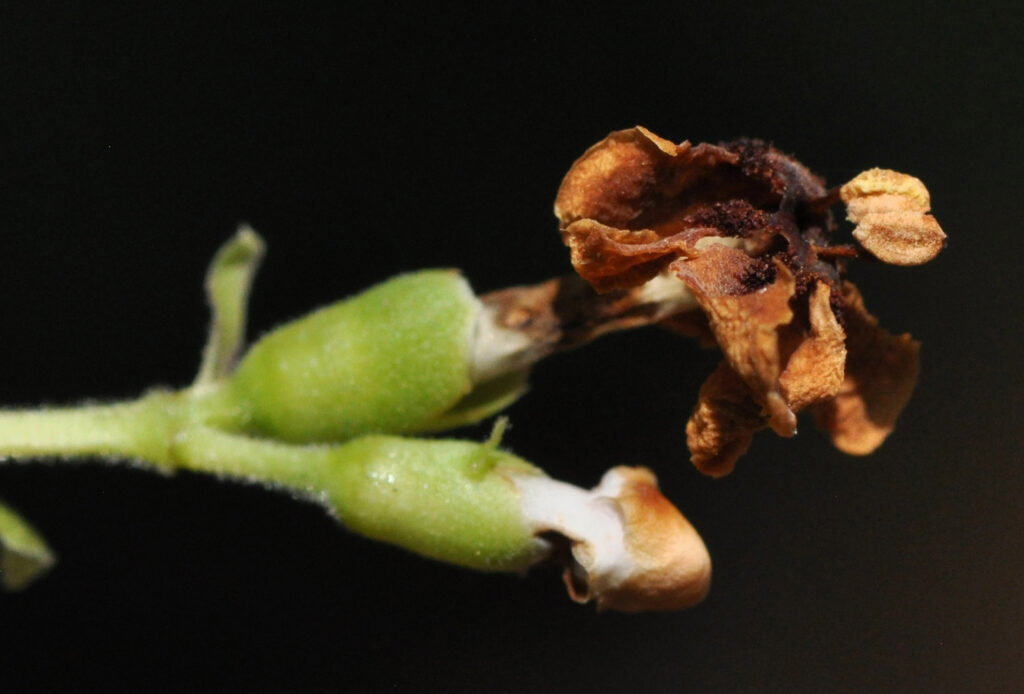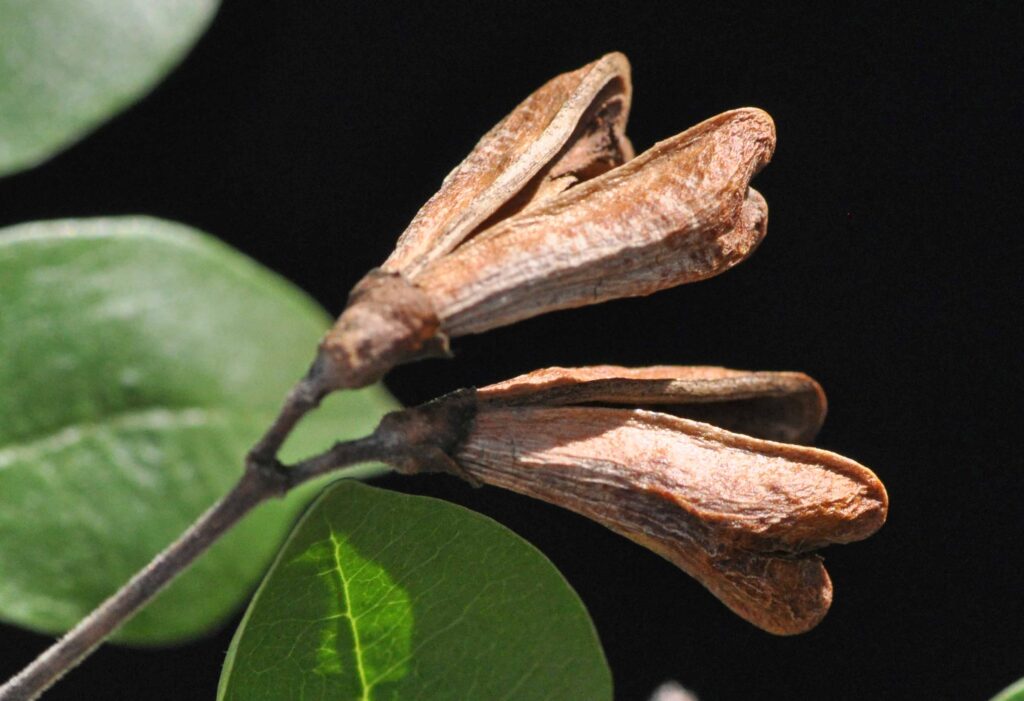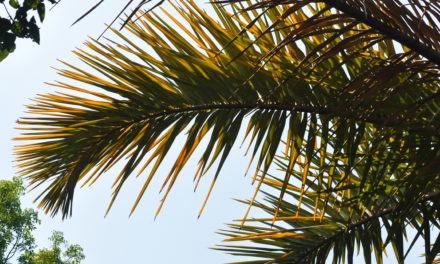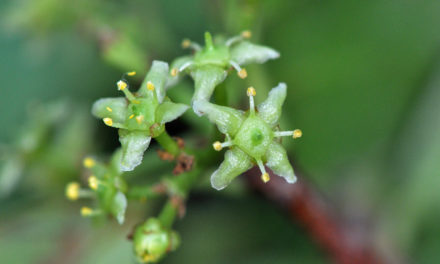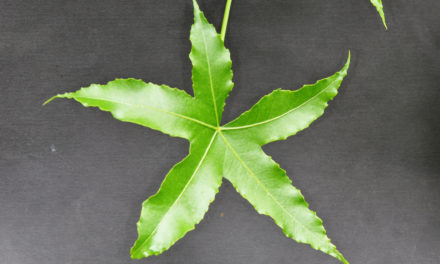General Info – summary
The spineless usually evergreen Tree is usually up to 5m high with a trunk up to 30cm wide. The opposite imparipinnate Leaves are smooth & entire with a winged rachis & petiole base. Regular, bisexual Flowers are heterostylous & in cymes. The green calyx surrounds the white hairy petals. Two stamens with short filaments & 1 pistil with a capitate stigma are present. Fruit: a woody, flattened capsule with winged seeds.
Description
Schrebera alata
Previous Names: Nathusia alata, Schrebera argyrotricha, Schrebera gilgiana, Schrebera latialata, Schrebera mazoensis, Schrebera saundersiae.
SA Tree No. 612.
Common names: (Afr) Houtpeer, Wildejasmyn, Vlerksteelhoutpeer. (Eng) Wing-leaved Wooden-pear, Wild Jasmine. (isiXhosa) umGwenya-hlungulu. (isiZulu), Umgwenyahlungulu, Umsishane-wehlanze, Umtshwatshwala. (siSwati) Sehlulamanya, Sehlulamanye. (siSwati) Sehlulamanya, Sehlulamanye. (Tshivenda), Mulungwi, Mutwari.
Family: Oleaceae (Olive, Jasmine and Privet family). Most members are trees. There are about 30 genera and 600 species in this family. Members can be climbers, shrubs or trees. Leaves lack stipules, are usually opposite and may be simple or compound. The actinomorphic (regular, symmetrical) Flowers are usually bisexual. The Calyx has 4 or more lobes. The Corolla is gamopetalous (united joined petals – at least at the corolla base and is removable as a single piece) and has 4 or more lobes. There are usually 2 epipetalous (born on or arising from the petals) Stamens. The Anthers open by longitudinal slits. The superior, 2-locular Ovary has a simple Style. In South Africa there are 5 genera and 22 indigenous species. Exotic species include Syringa and Fraximus (hard wood). Local genera with trees on this website include Schrebera and Olea.
Name derivation: Schrebera – after a German naturalist and author: J.C.D von Schreber (1739-1810). alata – winged: probably referring to the leaf rachis or possibly to the seeds. There are 2 species of the genus Schrebera in southern Africa. The other is S trichoclada – found to the North and East of South Africa.
Conservation: National Status: L C. (Least Concern). Assessed: 2005 (W. Foden and L. Potter).
Tree
Spines are absent on this small Tree. It has a sparse crown and is usually upright and up to 5m but may reach 15m high. It can also be a shrub. The Trunk is up to 30cm wide. The soft grey or light brown Bark has cracks (photos 795 and 594) or flakes irregularly (photo 794). Branches lack the short dense hairs present on Schrebera argyrotricha. Lenticels (usually raised corky oval or elongated areas on the plant that allows the uncontrolled interchange of gases with the environment) are visible on young branches (photo 902).
- 797. 2016/10/11. Pretoria NBG Photo: David Becking.
- 511. 2016/11/15. Pretoria NBG. Photo: David Becking.
- 795. 2016/10/11. Pretoria NBG. Photo: David Becking.
- 504. 2016/11/15. Pretoria NBG. Photo: David Becking.
- 794. 2016/10/11. Pretoria NBG. Photo: David Becking.
- 902. 2017/03/01. Pretoria NBG. Photo: David Becking.
Leaves
This mainly evergreen tree may be deciduous (photo 797 & 511 under Tree). The thickly or thinly leathery, opposite Leaves are imparipinnate (pinnately compound leaf ending in a single leaflet – photo 507). The Leaves are smooth, up to 14cm long and have tiny scales, which are not easy to see. Below the single terminal and often the biggest Leaflet, are up to 3 pairs of opposite leaflets (photo 507). Each leaflet is elliptic, oblong, and ovate or even obovate and usually up to 8 x 4cm. The upper surfaces of leaflets are glabrous (hairless), shiny or dull dark green and the lower surface is lighter and glabrous or pilose (shaggy with soft hairs) when young. Here leaflet Veins may be clearly visible (photo 508) and the side veins stop somewhat short of the margin. The Rachis (main axis – bearing leaflets in this case has green Wings (photo 507 & 508). The leaf Apex is bluntly pointed or rounded or even notched or acuminate (said of an acute apex whose sides are somewhat concave and taper to a protracted point). The tapering Base of the terminal leaflet is symmetric but those in the lateral leaflets may be asymmetric. The Margin is entire (with a continuous margin, not in any way indented – photo 508). Wings occur at the base of the up to 5cm long Petiole (leaf stalk – photo 507). The petiole clasps the stem at the base (photo 902). Petiolules (leaflet stalks) are short or absent and Stipules are absent.
- 507. 2016/11/15. Pretoria NBG. Photo: David Becking.
- 508. 2016/11/15. Pretoria NBG. Photo: David Becking.
Flowers
The small Jasmine-like Flowers are tubular and arranged in terminal panicle like (indeterminate, branched inflorescence with stalked flowers) Cymes (a flower cluster with a central stem bearing a single terminal flower that develops first, the other flowers in the cluster developing as terminal buds of lateral stems – photo 509) that are up to 11cm long. The sweet scented flowers are more perceptible in the early evening. Flowers are about 1,4cm in diameter and their colour changes from white to pink. They occur at branch-ends or in leaf axils. Each bisexual flower is actinomorphic (Regular, symmetrical. Flowers are vertically divisible into similar halves by more than 1 plane passing through the axis). Flowers are heterostylous (the condition in certain plants, such as the primrose and Schrebera, of having styles and, or anthers of different lengths in order to promote cross-pollination – photos 706 & 163). The green Calyx is campanulate (bell-shaped) and loosely surrounds the Corolla (photo 706). The well-developed cylindrical Corolla tube (photo 708) is up to 1,5cm long, and usually has 6+ spreading lobes and is about 1,5cm wide. These lobes become reflexed (photo 706). There are attractive brown to purplish hairs on the inside of the lobes near the mouth of the tube (photo 621 & 163). Arising from the corolla are 2 Stamens. Remains of these are visible in photo 163 (2) under Fruit. The short Filaments holding the Anthers appear just below the mouth of the petals (photo 621: dissected). These large anthers are introrse (turned or faced inward or toward the axis). There is a single Pistil (a unit of the Gynoecium, the female element of the flower, composed of the Ovary, Style and Stigma). The Style extends from the superior Ovary to beyond the petals and ends in a green, capitate (formed like a head) Stigma (photo 706). The nectar within the tubular flowers attracts insects, which are mainly responsible for Pollination. (Sep-May).
- 509. 2016/11/15. Pretoria NBG. Photo: David Becking.
- 708. 2017/01/31. Pretoria NBG. Photo: David Becking.
- 621. 2017/01/31. Pretoria NBG. Photo: David Becking. Dissected
- 163. 2017/12/26. Pretoria NBG. Photo: David Becking.
- 706. 2017/01/31. Pretoria NBG. Photo: David Becking.
Fruit
The initially bright green fruit – photo 163 (2), becomes light brown when mature (photo 579). The woody, ridged, shiny Fruit is a narrow or wide, and slightly ridged Capsule (a dry fruit resulting from the maturing of a compound ovary – of more than one carpel – usually opening at maturity by one or more lines of dehiscence – photo 579). This capsule is up to 3 x 1,5cm and has 2 Valves (separable parts of a pod; the units or pieces into which the capsule splits or divides in dehiscing). It ultimately releases about 8 papery winged, wind dispersed Seeds – each up to 1cm long. Seeds contain endosperm (the starch and oil-containing tissue of many seeds; often referred to as the albumen). (Feb-Jul).
- 163 (2). 2018/03/14. Pretoria NBG. Photo: David Becking.
- 579. 2016/11/22. Pretoria NBG. Photo: David Becking.
Distribution & Ecology
This Tree occurs in the Eastern Cape, KwaZulu-Natal, Mpumalanga, Limpopo, Eswatini (Swaziland) and northwards to Ethiopia (boarders on Kenya in the south). These plants are often located in the mist belts, dry bushveld, forests, forest margins and hillsides. Lichen (composite organism arising from a mutualistic relationship between fungi or cyanobacteria and algae species) may grow on the bark (grey/blue in photo 795 under Tree). Schrebera alata plants do best in a warm climate and are often found in an altitude range of 1 000 – 1 600m. The Greater Death’s Head hawkmoth (Acherontia atropos) feeds on this plant and others in the families Oleaceae and Solanaceae. These moths are large with a wingspan of 12cm or more. They may also cause problems within beehives. They occur from South Africa to Europe. Although these moths are harmless to humans, their reputation developed in horror films like “Dracula” and “Silence of the lambs.”
Ethnobotany
The Wood is pale brown with dark striations. It is durable, hard, relatively dense and is mainly used for fuel. This attractive relatively fast-growing tree grows well from Seeds. This is good garden prospect and may become a shapely tree in under 10 years.
References
Boon, R. 2010. Pooley’s Trees of eastern South Africa. Flora and Fauna Publications Trust, Durban.
Burrows, J.E., Burrows, S.M., Lotter, M.C. & Schmidt, E. 2018. Trees and Shrubs Mozambique. Publishing Print Matters (Pty) Ltd. Noordhoek, Cape Town.
Coates Palgrave, M. 2002. Keith Coates Palgrave Trees of Southern Africa, edn 3. Struik, Cape Town.
Foden, W. & Potter, L. 2005. Schrebera alata (Hochst.) Welw. National Assessment: Red List of South African Plants version 2020.1. Accessed on 2023/11/26.
Lawrence, G. H. M, 1951. Taxonomy of Vascular Plants. The Macmillan Company, New York. Tenth Printing 1965.
Palmer, E. & Pitman, N. 1972. Trees of southern Africa. Balkema, Amsterdam, Cape Town.
Schmidt, S. Lotter, M. & McCleland, W. 2002. Trees and Shrubs of Mpumalanga and the Kruger National Park. Jacana, Johannesburg.
van Wyk, B. & van Wyk, P. 1997 Field guide to Trees of Southern Africa. Struik, Cape Town.
http://plantzafrica.com/plantqrs/schreberaalata.htm
http://www.plantbook.co.za/schrebera-alata/
https://en.wikipedia.org/wiki/Schrebera_alata
http://tpittaway.tripod.com/sphinx/a_atr.htm
http://posa.sanbi.org/flora/browse.php?src=SP
Acherontia atropos — “Deathshead-hawkmoth” | Welcome, visitor! (breedingbutterflies.com)

